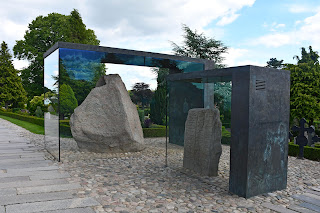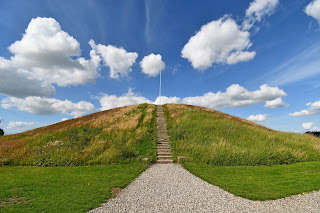Scandinavia Trip: Day 12 – Copenhagen and Jelling
I began my day as has become custom on this trip: with a juice from the supermarket and pastries from a local café. Since I had already seen the outer parts of Copenhagen, I decided that today would be the day when I would explore the centre. I first made my way to Rådhuspladsen, but I found the city hall undergoing major work to its main tower. Walking southeast, I took pictures of the Ny Carlsberg Glyptotek but did not go inside, as it was far too early and the museum was still closed. I also visited Slotsholmen, which houses Christiansborg Palace and the lovely Royal Library Garden.
Until around ten o’clock,
the weather was not great. Despite the optimistic weather forecast, it was
cloudy and windy, which made for a somewhat grey walk through the old town: I
wound my way past the Stork Fountain to the Church of the Holy Spirit and
Copenhagen Cathedral, which was open at the time. I was walking north to the
Round Tower and Rosenborg Castle when the sun finally came out. The gardens at
Rosenborg Castle looked particularly welcoming with the parting clouds, and I
spent quite a while simply milling about and taking pictures.
Thanking my lucky
stars for the good weather, I then walked east to visit Frederik’s Church. The
place of worship is a wonderfully symmetrical building with a warmly golden
altar. Also known as the Marble Church, the 18th century building
has the largest dome in Scandinavia. The church thus adds to an interesting
list of Danish primacies, which include the happiest population and the oldest
surviving monarchy in Europe.
As I made my way to
Nyhavn, the weather started to look as though it would spoil again. In
addition, I had already seen everything I had wanted to see in Central
Copenhagen (I have been weighing up whether to visit some museums and
galleries, but I am very sick of them after almost two weeks of travels).
Somewhat on a whim, therefore, I decided to take a train to a faraway place
that I had only vaguely considered visiting: Jelling.
Nestled comfortably in
the middle of the Jutland Peninsula, Jelling is usually reachable from
Copenhagen in around two and a half hours. Its claim to fame are two mounds and
two runestones that date to the unification of Denmark in the 900s. The first
Jelling stone was erected by King Gorm in honour of his wife Thyra. The second
and larger stone was commissioned by Gorm’s son Harald Bluetooth. Paying homage
to his parents, the stone celebrates Harald’s two major successes: unifying
Denmark and converting it to Christianity.
As for the mounds, the
northern mound was built over a Bronze Age burial site and contains the centre
of the longest known stone burial ship in the world. Its edges are thought to
extend 354 metres, that is, beyond the southern mound, which is somewhat bigger
but contains no burial. The northern mound is thought to be the place where
Harald Bluetooth buried his father. Between the mounds stands a small white
church, a successor to the wooden churches constructed during and after
Harald’s lifetime.
My journey to Jelling
was a veritable mess. The train was supposed to depart at 11:45 but left at
around 12, and as it forged ahead, its delay kept getting longer. It was almost
three by the time we reached Fredericia on the eastern coast of Jutland; I
decided to get off there instead of Vejle, which had been my original plan, as
I could not quite understand the announcements made on the train. In somewhat
broken English, the conductor seemed to be saying that because of the train’s
delay, it would leave out some stops, and I feared Vejle might be one of them.
Although I was worried
that I would miss my connection in Fredericia, the train from Fredericia had
already amassed a delay of almost half an hour. Standing at the platform while
eating ice cream, I noticed that two trains were supposed to be leaving it at
the same time. I puzzled over this contradiction until I eventually summoned
the courage to ask another passenger. With what appeared to be amusement at my
ignorance, he explained that the trains would part ways at one of the following
stations but until then, they would ride together – the electronic board even
showed which wagon was travelling to each terminal station.
I contented myself
with this explanation for a while, but when the train arrived, a new kind of
chaos gripped the platform. All of a sudden, the electronic board rerouted the
other train to a different platform, but the passengers as well as the
conductors on the first train still quite logically believed themselves to be
travelling to Aalborg rather than Struer. Given this conflicted information, I
could not quite bring myself to board the train, but I could not stand by
either. I asked conductor after conductor and passenger after passenger about
where the train was going but nobody seemed to agree or to know for sure.
Finally, the matter
was resolved when the conductors started ushering people out from the train and
directing them to the new train headed towards Aalborg. The entire bizarre
operation took at least fifteen minutes, and I would have been completely lost
in the chaos had I not bumped into a young man who seemed to grasp what was
going on. After he explained the situation to me, we sat down in the train
together and conversed until I finally arrived at my destination – at half past
four!
I learned many new
things about Denmark from this conversation: their equivalent of the rust belt
is the Rotten Banana, they have Folk High Schools that are neither high schools
nor universities, and they love liquorice despite most brands using artificial
flavouring instead of good old roots. In the evening, I managed to file a
request for a refund to my ticket on the railway website; the application was
entirely in Danish to minimise the likelihood of foreigners getting their
refunds, but luckily Danish is quite simple.











































Comments
Post a Comment